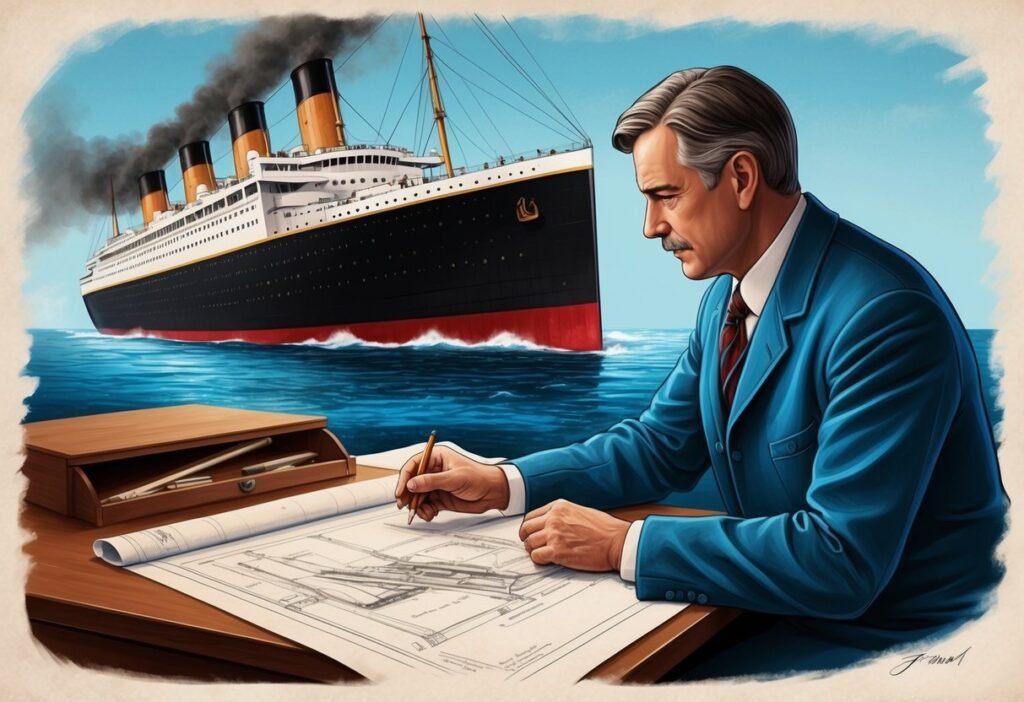Table of Contents
Many inventors have met tragic ends testing their own creations. These innovators pushed the boundaries of science and technology, sometimes at great personal risk. Their stories serve as cautionary tales about the dangers of pushing too far too fast.

Some famous inventors killed by their own inventions include Otto Lilienthal, Franz Reichelt, and Thomas Midgley Jr. Lilienthal died in a glider crash in 1896. Reichelt fell to his death from the Eiffel Tower in 1912 while testing a wearable parachute. Midgley was strangled by a pulley system he designed to help him get out of bed.
More recently, Stockton Rush died in 2023 when his Titan submersible imploded during a deep-sea expedition to view the Titanic wreck. While these inventors’ fates were unfortunate, their work often led to important advances that benefited society. Their sacrifices remind us of both the risks and rewards of technological progress.
Video Showing These Tragic Incidents
Progress and Peril: Inventors Who Faced Fatal Consequences

Some inventors paid the ultimate price in pursuit of their ideas. These pioneers pushed boundaries but met tragic ends testing their creations.
The Tragic Tale of Ismail ibn Hammad al-Jawhari and His Flight Ambitions
Ismail ibn Hammad al-Jawhari was a 10th-century Turkish scholar with a passion for flight. He built large wooden wings and jumped from the roof of a mosque in Nishapur, Iran. Sadly, his wings failed to lift him. Al-Jawhari fell to his death in front of a crowd.
His attempt showed the risks early flight pioneers faced. While his design didn’t work, it sparked ideas in others. Al-Jawhari’s story reminds us of the human drive to achieve the impossible.
Robert Cocking’s Descent: A Parachute Experiment Gone Wrong
Robert Cocking, an English painter, had big dreams about parachutes. In 1837, at age 61, he tested his cone-shaped design. Cocking jumped from a hot air balloon 5,000 feet above London.
His parachute broke apart in mid-air. Cocking fell to his death near Lee, Kent. The tragic event shocked the public. It led to new safety rules for air shows. Cocking’s fate shows how inventors often risk their lives to test new ideas.
Radiation’s Double-Edged Sword: Marie Curie’s Pioneering Research

Marie Curie’s groundbreaking work on radioactivity led to major scientific advances. But it also exposed her to dangerous levels of radiation that likely caused her death.
Radium Discovery and the Cost of Scientific Breakthroughs
Marie Curie discovered radium in 1898 along with her husband Pierre. This radioactive element opened up new possibilities in medicine and physics. Curie spent years working closely with radium samples in her lab.
At the time, scientists did not fully understand the risks of radiation exposure. Curie often carried test tubes of radioactive materials in her pockets. She stored radium samples in her desk drawer.
Over time, Curie’s health declined from radiation poisoning. She developed aplastic anemia, a blood disorder caused by radiation damage to bone marrow. This condition led to her death in 1934 at age 66.
Curie was not the only scientist harmed by early radiation research. Dr. Sabin Arnold von Sochocky invented luminescent paint using radium. He later died from radium poisoning after years of exposure.
Curie’s fate highlights the dangers faced by pioneering researchers. Her work laid the foundation for nuclear physics and cancer treatments. But it came at a high personal cost.
The Blinded Visionary: Thomas Midgley Jr. and Chemical Innovations

Thomas Midgley Jr. created two important chemicals in the 1920s. These inventions changed the world but also caused big problems for human health and the environment.
The Invention of Leaded Petrol and Its Toxic Legacy
In 1924, Midgley developed tetraethyl lead as an additive for gasoline. This chemical made car engines run better and stopped them from making knocking sounds. Car companies loved it and started using it a lot.
But leaded gasoline was very dangerous. It released toxic lead into the air when cars burned it. This caused health issues for many people, especially kids. Lead can harm brains and cause other serious problems.
Midgley himself got sick from working with lead. He had to take time off to recover. Despite this, leaded gas was used for decades before being banned.
Chlorofluorocarbons and the Refrigeration Revolution
Midgley’s next big invention was chlorofluorocarbons (CFCs) in 1930. CFCs were used as coolants in refrigerators and air conditioners. They worked really well and didn’t catch fire easily.
CFCs quickly became popular. They made refrigerators safer and cheaper. This helped more people get refrigerators in their homes.
But CFCs had a hidden danger. Scientists later found out that they harm the ozone layer. The ozone layer protects Earth from harmful sun rays. CFCs were banned in the 1980s to help save the ozone layer.
Midgley’s work shows how inventions can have good and bad effects. His chemicals helped solve problems but also created new ones that weren’t known at first.
Engineering the Unsinkable: Thomas Andrews and the Titanic Fate

Thomas Andrews, the chief designer of the Titanic, helped create what was meant to be an unsinkable ship. His innovative designs and cutting-edge engineering would tragically prove insufficient when put to the ultimate test.
Designing the Titanic: A Marvel of Maritime Engineering
Thomas Andrews led the design team for the Titanic at Harland and Wolff shipyard in Belfast. The ship was massive, measuring 882 feet long and 175 feet high.
Andrews used advanced safety features like watertight compartments and remotely activated doors. These were meant to keep the ship afloat even if damaged.
The Titanic had luxurious amenities including ornate dining rooms, a swimming pool, and a gym. Andrews aimed to make it the most impressive ocean liner ever built.
On April 14, 1912, the Titanic struck an iceberg on its maiden voyage. Andrews quickly assessed the damage and knew the ship would sink.
He spent his final hours helping passengers into lifeboats. Andrews went down with his creation, last seen in the first-class smoking room as the ship sank.
The Drive for New Frontiers: Max Valier’s Rocketry Risks

Max Valier pushed the limits of rocketry in the early 20th century. His work with liquid-fuelled rocket engines led to groundbreaking advances but also put him in harm’s way.
Pushing the Limits with Liquid-Fuelled Rocket Engines
Max Valier was an Austrian rocketry pioneer who lived from 1895 to 1930. He helped start the German Spaceflight Society and worked on the Opel-RAK rocket program.
Valier’s passion for rockets drove him to take big risks. He tested rocket-powered cars and sleds, which got a lot of public attention.
In 1930, Valier started working on liquid-fuelled rocket engines. These were more powerful than solid-fuel rockets but also more dangerous.
On May 17, 1930, Valier was testing a new liquid-fuelled engine. The engine exploded unexpectedly. Valier died from his injuries just ten minutes later. He was only 35 years old.
Valier’s death shocked the rocketry community. It showed how risky early rocket research could be. But his work helped pave the way for future space travel.
Transfusing Life and Death: Alexander Bogdanov’s Blood Work

Alexander Bogdanov was a Russian doctor who pioneered blood transfusion research in the early 1900s. He believed transfusions could extend life and even reverse aging. His experiments pushed medical boundaries but ultimately led to his own demise.
The Blood Transfusion Experiments That Cost a Life
Bogdanov started doing blood exchanges on himself and volunteers in 1924. He thought swapping blood between young and old people could make the elderly healthier.
Over 4 years, Bogdanov did 11 transfusions on himself. At first, he felt great – more energetic and clear-minded. This fueled his belief in blood’s rejuvenating powers.
But in 1928, things went wrong. Bogdanov got blood from a student with tuberculosis and malaria. Within hours, he had a bad reaction. His organs failed and he died days later at age 54.
Bogdanov’s death showed the risks of uncontrolled medical testing. Still, his work helped advance transfusion science. The institute he founded still operates in Moscow today.
Struck Down by Curiosity: Georg Wilhelm Richmann’s Electrifying Demise

Georg Wilhelm Richmann was a Russian physicist who studied electricity in the 18th century. His work on capturing electricity from lightning led to a shocking and fatal accident.
Harnessing Electricity from Lightning: A Deadly Experiment
Richmann built a metal rod to collect electricity from storm clouds. On August 6, 1753, he prepared to measure a thunderstorm’s electrical charge. As Richmann stood near his equipment, a ball of blue-white fire shot from the rod.
The lightning strike hit Richmann’s forehead. He fell backwards without a sound. His assistant, engraver Sokolaw, witnessed the tragic event.
Richmann’s death proved the dangers of Benjamin Franklin’s lightning rod experiments. It showed that electricity from storms could be deadly if not handled carefully.
The scientific community was shocked by Richmann’s fate. His work helped prove theories about electricity and lightning. But it came at the ultimate cost – his own life.
Richmann’s story serves as a warning about the risks of cutting-edge research. It reminds us that even brilliant minds can fall victim to nature’s power.

